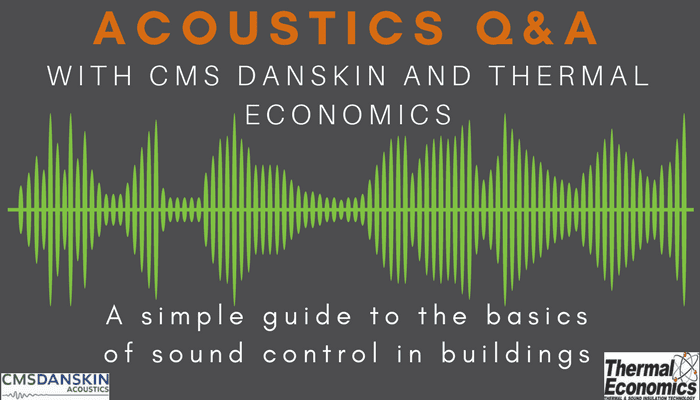Acoustics Q & A

The World of Acoustics
Acoustics Q & A. The world of acoustics is a complex one, and if you are looking to find a solution to sound control in a building, it can sometimes be hard to know where to start or to fully understand the complexities of a project. But worry not, as we have put together this Q&A guide to answer some basic questions, which you can refer to if you are new to the world of acoustics. This is by no means a fully comprehensive guide to acoustics, but we hope that it will provide a starting point in helping you to understand some fundamental principles.
To answer our questions, we caught up with some experts in the field – Thomas Snaylam, Area Sales Executive for CMS Danskin and Graham Lyon, Technical Manager at Thermal Economics. Both companies are big players in the industry and both provide excellent technical support to their customers, so their individual responses below will provide a useful starting point to broadening your knowledge on the subject.
What is sound transmission?
CMS:
Sound transmission is noise or sound energy traveling from one place to another.
Thermal Economics:
When a sound is made pressure waves (soundwaves) radiate from the source. These waves can travel through air, solids and liquids. This means that when a sound is made within a building it can be transmitted through any air paths and also the structure itself. It is possible that you may be able to hear a sound created in a room in a completely different part of the building, some distance from the source, as the sound waves have travelled through the structure.
What causes sound transmission in buildings?
CMS:
Sound transmission in buildings can occur from several sources, the most common sources are;
Human footfall
Human speech
Machine noise (washing machine, dryer etc.)
Household items – televisions – hairdryers – treadmills etc.
Thermal Economics:
There are many sources of sound in a building depending on its use. TV’s and radios, footfall sound and children playing are common causes in domestic buildings. Many domestic appliances and some types of building plant can also be problematic, sending vibrations through the structure which can be heard as sound in other areas of the building.
What are the different types of sound that can be transmitted through buildings?
CMS:
Impact – footfall noise transferring from the above.
Airborne – talking / TV noise
Vibration / Structural – Generally where there is an oscillating source (Fan / Treadmill), that transmits through the buildings structure.
Reverberation – Echo noise within a space, this can be countered with having soft porous materials being added.
Thermal Economics:
Sound transmission can usually be categorised as impact sound (e.g. footfall) or airborne sound (e.g. talking / shouting).
How can noise levels of these different types of sound be controlled?
CMS:
Impact – Add a resilient layer
Airborne – generally adding mass to the system, sometimes a decoupling resilient layer also to help reduce transmission of sound energy.
Vibration / Structural – by calculating the frequency of the noise source, the mass of the source then a calculation can be done to help isolate the system.
Thermal Economics:
The main methods used to control sound transfer are:
Air paths – Blocking air paths within the structure helps to prevent sound transfer. Common examples include between floor boards, at wall and floor junctions and around service penetrations.
Mass – generally the more mass the better. This is not an issue in heavy concrete structures, but in lightweight timber and steel structures additional layers of plasterboard, chipboard etc. may be required to increase the overall mass. Products such as our Isosonic Screed Plank (ISP) have been specifically designed to add mass in the thinnest layer possible.
Construction depth – this is often the most difficult method to use as it needs to be designed in at the start of the project, and increasing the thickness of a construction usually increases cost.
Isolation – Isolating mats, hangers and brackets can be used to reduce the transfer of sound through a building. This is what we specialise in and our Isorubber range of acoustic mats can provide isolation solutions for almost all types of floor construction. They have been at the forefront of the acoustic market since the current regulations can into force in 2003, so you know that they are tried and tested solutions.
How is sound transmission measured?
CMS:
Sound transmission is measured in two different ways for Part E compliance, impact and airborne noise.
Impact noise is measured by placing a mechanical tapping machine on the floor above and a Sound Level Meter (receiver microphone) on the floor below then recording the readings that are taken in the below dwelling.
Airborne noise is measured by placing a white or pink noise generator in a receiving room, and a Sound Level Meter (receiver microphone) in the source room, this test is done for floors and separating walls. The white noise generator is turned on and the noise level in receiver room is recorded, result is the difference between noise in the source room and the receiver room.
Thermal Economics:
A sound test can be carried out by a certified person. Walls can be tested for airborne sound performance and floors can be tested for impact and airborne sound performance.
In an airborne test a speaker is used to create a constant steady sound in a room. The sound level (in dB) is measured in the room with a sound meter, and then measured again in the adjoining room. The difference between these values is the airborne sound reduction provided by the wall or floor.
An impact test uses a tapping machine to continually drop small “hammers” onto the floor surface. The sound level is measured in the room below with a sound meter.
What are the regulations on sound transmission in buildings?
Thermal Economics:
The building regulation requirements for domestic sound transmission are set out in Approved Document Part E in England & Wales or Technical Handbook Section 5 in Scotland. There are different requirements for new build and refurbishment projects.
| Impact (floors) | Airborne (walls & Floors) | ||
| Approved Document Part E England / Wales | New Build | 62dB (max) | 45dB (min) |
| Refurbishment | 64dB (max) | 43dB (min) | |
| Technical Handbook Section 5 Scotland | New Build | 56dB (max) | 56dB (min) |
| Refurbishment | 58dB (max) | 53dB (min) | |
Sound testing of a percentage of dwellings is usually required to prove compliance, however if you do not wish to forgo paying for testing and the risk of failing to meet the requirements another option is available. The Robust Details are a collection of floor and wall details that are proved to exceed the building regulation requirements. If you register with Robust Details and build from constructions from their handbook a sound test is not required.
What is flanking?
CMS:
Flanking noise is sound energy reaching a receiver by an indirect path, i.e. through a structural wall or ceiling.
Thermal Economics:
Thermal Economics Flank
Poor design can allow sound to bypass or “flank” around an element of a structure that has been acoustically treated.
Flanking sound travels indirectly from one room to another via direct contact paths such as external walls, structural steelwork and service voids.
Flanking sound is one of the most common causes of sound test failures. This is why we created the IsoEdge range of flanking insulation. These products are used to isolate these sound paths and reduce flanking sound transmission.
What do I need to consider when finding a solution to sound transmission?
CMS:
Budget
Performance / specification
Type of structure
Use of building
Purpose of material
Installation
Thermal Economics:
A good solution should be simple to install, made up of high quality products and designed for the purpose.
The most effective solutions are those that are easy to install as the performance of a system can be completely compromised if fitted incorrectly.
The quality of products also plays a big part in the system performance and also its longevity. Some of the cheaper foam isolation mats are very low in mass, are easily damaged, and can lose performance over time.
The Isorubber range of isolation mats are dense, robust and designed to perform for the lifetime of a building making them far more fit for purpose.
What are the differences between sound absorption and reduction?
CMS:
Sound absorption is the conversion of sound energy to heat via frictional loss, generally measured in seconds.
Sound reduction is the reduction of sound from a particular source; this is generally measured in dB.




